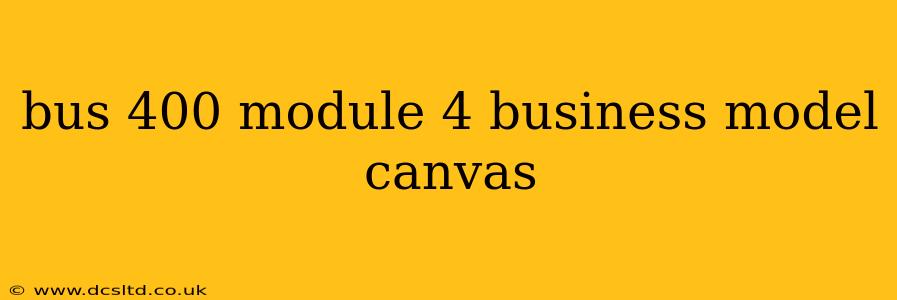The Business Model Canvas, a strategic management and lean startup template, is a crucial tool for understanding and visualizing how a business creates, delivers, and captures value. This comprehensive guide delves into the nine building blocks of the Business Model Canvas, offering insights relevant to BUS 400 Module 4 and beyond. We'll explore each component in detail, providing practical examples and addressing common questions.
Understanding the Nine Building Blocks of the Business Model Canvas
The Business Model Canvas is structured around nine interconnected elements:
1. Customer Segments: Who are your target customers? Defining your customer segments is paramount. Consider demographics, psychographics, needs, and behaviors. Are you targeting multiple segments with different needs and value propositions? A clear understanding of your customer segments informs every other aspect of your business model.
2. Value Propositions: What unique value do you offer to each customer segment? This is the core of your business – what problem are you solving, and what benefits are you providing? Your value proposition must resonate with your target audience and differentiate you from competitors. Examples range from cost leadership to niche specialization.
3. Channels: How will you reach your customer segments? This encompasses all the touchpoints customers use to discover and interact with your business. Think online channels (website, social media), offline channels (retail stores, partnerships), and the customer journey itself. Efficiency and effectiveness in channel selection are vital.
4. Customer Relationships: What type of relationship do you establish with each customer segment? This could involve personalized service, automated interactions, self-service, or community building. Understanding customer preferences and tailoring your relationships accordingly improves loyalty and retention.
5. Revenue Streams: How do you generate revenue? Identify all potential sources of income, such as sales, subscriptions, advertising, licensing, etc. Analyzing revenue streams is key to profitability and financial sustainability.
6. Key Activities: What are the most important activities to deliver your value proposition? These are the core activities your business must perform effectively. This could include production, problem-solving, platform/network operation, etc.
7. Key Resources: What key resources enable your value propositions? This includes physical resources (factories, equipment), intellectual resources (brand, patents), human resources (skilled employees), and financial resources. Identifying these resources is vital for resource allocation.
8. Key Partnerships: Who are your key partners and suppliers? Collaborations and strategic alliances can provide crucial resources and capabilities that your business might not possess internally. This can range from strategic partnerships to supplier relationships.
9. Cost Structure: What are the most important costs inherent in your business model? This involves analyzing both fixed costs (rent, salaries) and variable costs (materials, production). Understanding your cost structure helps in optimizing profitability and managing expenses effectively.
Frequently Asked Questions (PAA) about the Business Model Canvas
While specific questions related to BUS 400 Module 4 may vary, here are some common queries about the Business Model Canvas:
How does the Business Model Canvas differ from a business plan?
The Business Model Canvas provides a concise visual representation of a business model, while a business plan is a more detailed and comprehensive document encompassing market analysis, financial projections, and operational strategies. The Canvas is a valuable tool for developing and refining the core business model, often serving as a foundation for a more extensive business plan.
What are some common mistakes when using the Business Model Canvas?
Common mistakes include neglecting to thoroughly define customer segments, failing to articulate a clear value proposition, overlooking key partnerships, and underestimating cost structures. It's also crucial to avoid static thinking – the canvas is a dynamic tool that should be iteratively refined as the business evolves.
How can I use the Business Model Canvas to test my business idea?
The Business Model Canvas facilitates iterative testing. You can use it to identify potential weaknesses, validate assumptions, and pivot your business model based on feedback. The canvas allows you to quickly test different aspects of your business model, making it a valuable tool for lean startups and agile businesses.
Can I use the Business Model Canvas for non-profit organizations?
Absolutely! While the language often focuses on "revenue streams," the core principles of value proposition, customer relationships, and key activities apply equally to non-profit organizations. Instead of revenue, you'll focus on the social or environmental impact and the resources required to achieve your mission.
This deep dive into the Business Model Canvas provides a foundational understanding for your BUS 400 Module 4 work and beyond. Remember that the power of this tool lies in its iterative nature and its ability to foster collaborative discussion and strategic thinking within your team. By thoroughly understanding and applying the nine building blocks, you can create a robust and successful business model.
